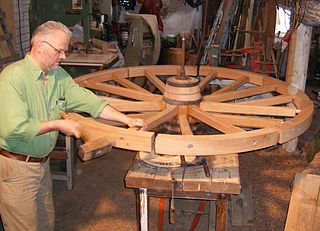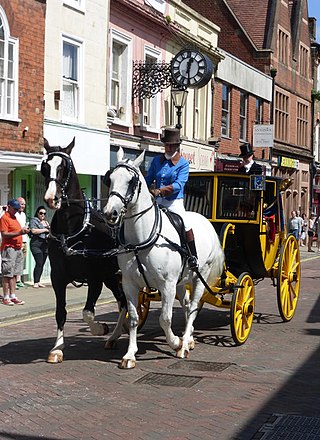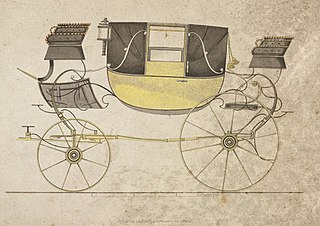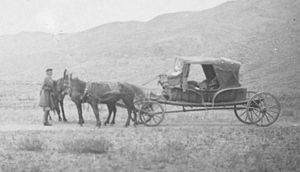
A cart or dray is a vehicle designed for transport, using two wheels and normally pulled by draught animals such as horses, donkeys, mules and oxen, or even smaller animals such as goats or large dogs.

A stagecoach is a four-wheeled public transport coach used to carry paying passengers and light packages on journeys long enough to need a change of horses. It is strongly sprung and generally drawn by four horses although some versions are drawn by six horses.

A carriage is a private four-wheeled vehicle for people and is most commonly horse-drawn. Second-hand private carriages were common public transport, the equivalent of modern cars used as taxis. Carriage suspensions are by leather strapping or, on those made in recent centuries, steel springs. Two-wheeled carriages are informal and usually owner-driven.

The Ackermann steering geometry is a geometric arrangement of linkages in the steering of a car or other vehicle designed to solve the problem of wheels on the inside and outside of a turn needing to trace out circles of different radii.

A wagon or waggon is a heavy four-wheeled vehicle pulled by draught animals or on occasion by humans, used for transporting goods, commodities, agricultural materials, supplies and sometimes people.

A buggy refers to a lightweight four-wheeled carriage, drawn by a single horse, though occasionally by two. Amish buggies are still regularly in use on the roadways of America. The word "buggy" has become a generic term for "carriage" in America.

A wheelwright is a craftsman who builds or repairs wooden wheels. The word is the combination of "wheel" and the word "wright" as in shipwright and arkwright. This occupational name became the English surname Wright. It also appears in surnames like Cartwright and Wainwright. It corresponds with skilful metal workers being called Smith.

A sulky is a lightweight cart used for harness racing. It has two wheels and a small seat for only a single driver. The modern racing sulky has shafts that extend in a continuous bow behind the driver's seat, with wire-spoked "bike" wheels and inflated tyres. A sulky is frequently called a "bike". Historically, sulkies were built for trotting matches and made from wood with very tall wheels and almost no body, just a simple frame supporting a single seat. Such vehicles were called "sulkies" because they were "said to have been chosen by unsociable people fond of their own company or fits of sulking".

A barouche is a large, open, four-wheeled carriage, both heavy and luxurious, drawn by two horses. It was fashionable throughout the 19th century. Its body provides seats for four passengers, two back-seat passengers vis-à-vis two behind the coachman's high box-seat. A leather roof can be raised to give back-seat passengers some protection from the weather.

A Berlin carriage was a type of covered four-wheeled travelling carriage with two interior bench seats facing one-another. Initially noted for using two chassis rails and having the body suspended from the rails by leather straps, the term continued in use for enclosed formal carriages with two seats after the suspension system changed from leather straps to steel springs.

A post-chaise is a fast carriage for traveling post built in the 18th and early 19th centuries. It usually had a closed body on four wheels, sat two to four persons, and was drawn by two or four horses.

A horse-drawn vehicle is a piece of equipment pulled by one or more horses. These vehicles typically have two or four wheels and were used to carry passengers or a load. They were once common worldwide, but they have mostly been replaced by automobiles and other forms of self-propelled transport but are still in use today.

A lorry or lorrie was a low flat horse-drawn vehicle with no sides, related to the trolley and dray.

A dogcart is a two-wheeled horse-drawn vehicle pulled by a single horse in shafts, or driven tandem. With seating for four, it was designed for sporting shooters and their gun dogs, with a louvred box under the driver's seat to contain dogs. It was developed in the early 1800s to afford more seating than the gig, which seats only two. Seating is two back-to-back crosswise seats, an arrangement called dos-à-dos from French. There is a hinged tailboard which lowers slightly and, supported by chains, acts as a footrest for the rear-facing passengers. Some dogcarts had a mechanism to slide the entire body forward or rearward along the shafts to help balance the weight for the horse.

A tonga or tanga is a two-wheeled carriage drawn by a single horse. It is used for transportation in the Indian subcontinent. There is a canopy over the body, one seat faces forward for the driver and one passenger, and one seat faces the rear for a second passenger. Some space is available for baggage below the carriage, between the wheels. This space is often used to carry hay for the horses.

In coachbuilding, a landau is a four-wheeled carriage with a roof that can be let down. It was a luxury carriage. The low shell of the landau provides maximal visibility of the occupants and their clothing, a feature that makes a landau still a popular choice for Lord Mayors in the United Kingdom on ceremonial occasions.

A droshky or drosky is a term used for a four-wheeled open carriage used especially in Russia. The vehicle has a long bench on which the driver or passengers sit as if on a saddle, either astride or sideways. From droga, the pole that connects the front and rear axles.

A surrey is a doorless, four-wheeled carriage popular in the United States during the late 19th and early 20th centuries. Usually two-seated and holding for four passengers, surreys had a variety of tops that included a rigid, fringed canopy, parasol, and extension. The seats were traditional, spindle-backed, bench seats. Before the advent of automobiles, these were horse-drawn carriages.

The Concord coach was an American horse-drawn coach, often used as stagecoaches, mailcoaches, and hotel coaches. The term was first used for the coaches built by coach-builder J. Stephen Abbot and wheelwright Lewis Downing of the Abbot-Downing Company in Concord, New Hampshire, but later to be sometimes used generically. Like their predecessors, the Concords employed a style of suspension and construction particularly suited to North America's early 19th century roads. Leather thoroughbraces suspend passengers who are in constant motion while the coach is moving. The swaying is accepted by passengers for the shock absorbing action of the leather straps and for the way the special motion eases the coach over very rough patches of roadway. This suspension, which was developed by Philip de Chiese in the 17th century, was long replaced by steel springs in England.

A coupé was a four-wheeled carriage with outside front seat for the driver and enclosed passenger seats for two persons. The name coupé comes from the French past participle of couper, "cut".



















